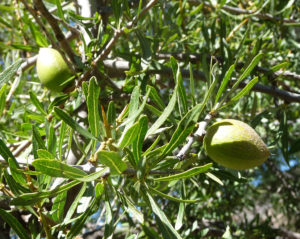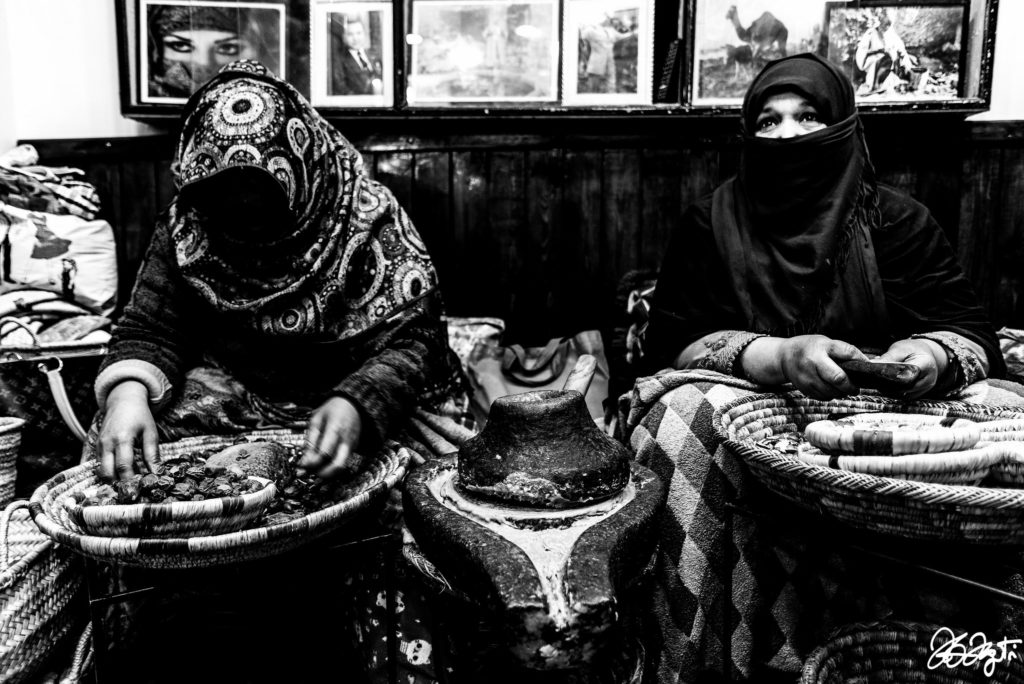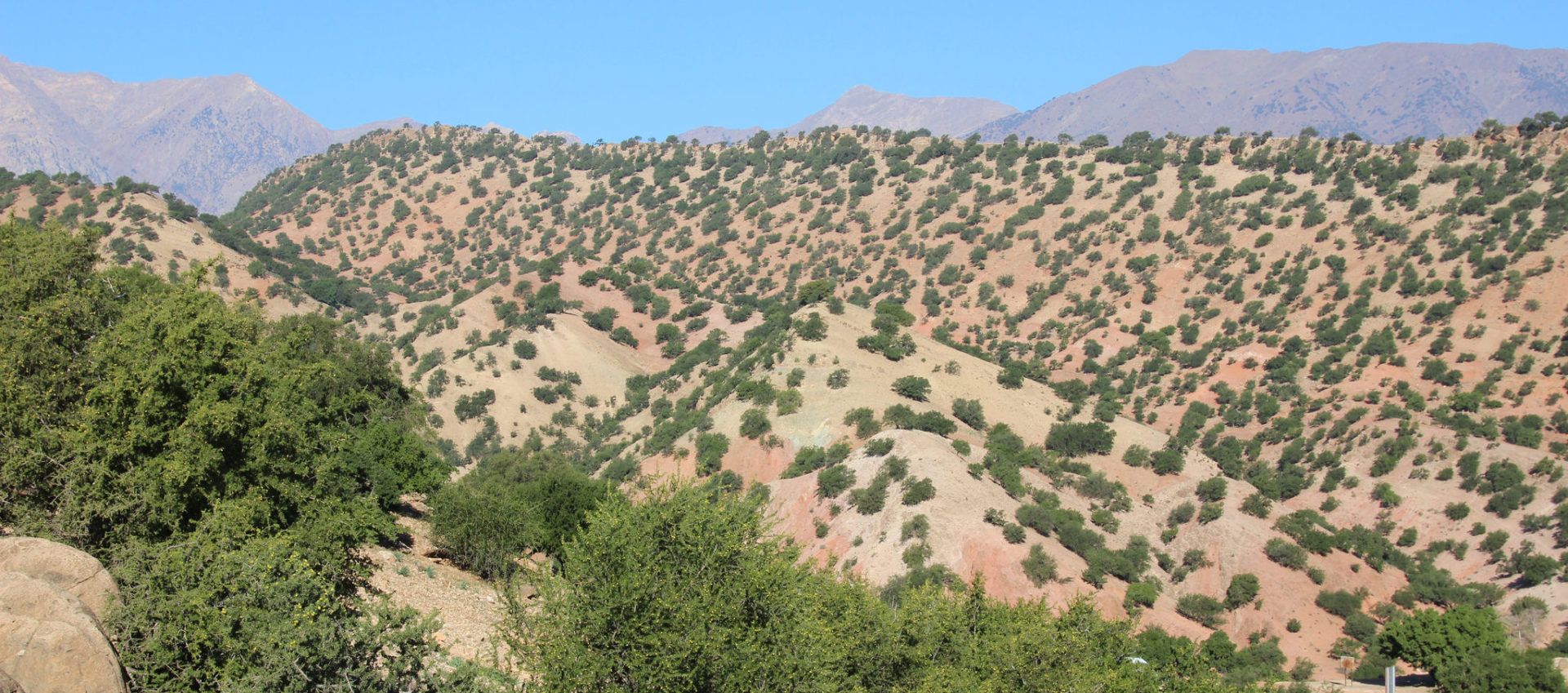It wasn’t long after the cairns appeared in the forest that women from surrounding villages began using them in a purification rite that ended in leaving underwear on the stone mounds. The cairns were new to the forest, but the women’s purification rite was not. In the ritual, older Berber women guided younger women into the forest, and the younger women washed themselves under the open sky and prepared their spirits for finding a lover. Forest rangers had built the cairns to mark the borders of Morocco’s national forests. They were designed to protect argan trees – which some Berber call the “tree of the devil” – from use and harvesting. But the local women turned the cairns into something else.
When Morocco’s government established Souss-Massa National Park in 1991, the Berber people were already familiar with temporary prohibitions on forest use, says anthropologist Romain Simenel of the Institute of Research for Development in Marseille, France. But they were accustomed to setting the prohibitions themselves, through a system called agdal, which involves religious stories laden with mischievous genies who curse parts of the forest, and community rituals that reopen the way to harvesting or grazing among the argan trees.
Instead, national authorities were now insisting on prohibiting access to a core zone of the argan forest, allowing limited access to a second zone, and leaving a third zone to more community-led use. They sought to protect the forest from both desertification and local land management decisions. But the genies in the argan forest are not easy to tame.
“This is a mille-feuille,” Simenel says, referring to the many layers in which overlapping international, national, and local legal traditions clash with each other and with local spiritual values. A wealth of research points to the importance of recognising the practices and values of local communities in setting up management schemes,1 1. Masterson, V. A. 2016. Sense of place and culture in the landscape of home: Understanding social-ecological dynamics on the Wild Coast, South Africa. PhD dissertation. Stockholm Resilience Centre, Stockholm University, Stockholm. See all references but that may be incomplete in the argan forest. Instead, the conflicts over how the argan forest should be used and by whom threaten to undermine the future of an agroforestry system full of spiritual, ecological, and economic value.

A map of Morocco showing the Unesco site and its zoning. The close-up of Souss Massa national park shows how the “core zones” there is divided into areas where traditional use is allowed and areas that are protected from use (in red hashes). Illustration: E. Wikander/Azote
Relic agroforestry
Argan trees may have evolved as long as 80 million years ago, and their present range of around 800,000 hectares in south-western Morocco is a small fraction of what it was in wetter times. Human exploitation of argan trees as food, medicine, and even cosmetics may date back to the Phoenicians over 3,000 years ago2 2. Charrouf, Z., D. Guillaume. 2018. The argan oil project: going from utopia to reality in 20 years. OCL, 25(2), D209. Link to article See all references and is documented in the 13th century The Book of Medicinal and Nutritional Terms by doctor Ibn al-Baitar.
Left to its own devices, the tree is more of an overgrown shrub, growing dense thickets just a few metres high. It grows slowly, withstanding droughts, and can live for a couple of centuries. It also produces a small fruit, like an olive with a hard pit.

The argan fruit from which oil is extracted. Photo: gailhampshire/flickr
But little of the argan forest is left to its own devices today, nor has it been left alone in the long human history of argan forestry. Men in the argan communities prune the branches and build stone barriers to manage sprouting roots. They cut terraces into hillsides to help the trees trap enough water. Community members gather the fruit, dry it, pulp it, crack open the hulls, and press oil from the kernels. They also use the trees to shade grazing animals, to protect watersheds by preventing soil erosion, as an emergency reserve of food for animals, and as a source of construction material and firewood.3 3. Genin & Simenel. 2011. Endogenous Berber Forest Management and the Functional Shaping of Rural Forests in Southern Morocco: Implications for Shared Forest Management Options. Human Ecology 39:257–269 DOI 10.1007/s10745-011-9390-2 Link to article See all references
French colonial authorities treated argan trees as a wild – and therefore national – resource4-5 4. Turner, B. 2006. Competing global players in rural Morocco: upgrading legal arenas. Journal of Legal Pluralism 53-54 Link to article 5. Orwa C, A Mutua, Kindt R, Jamnadass R, S Anthony. 2009. Agroforestree Database:a tree reference and selection guide version 4.0 Link to pdf See all references that should be protected from local use in the way endangered species are protected, as part of a wider natural patrimony. Yet throughout the early 20th century the region’s inhabitants managed the trees and sold the dense wood for charcoal, among other uses, despite the colonial regulations. A 1925 update to the forestry law restored some rights to municipal authorities, setting national interests in conservation and community-level interests in managed exploitation on a slow collision course.
For example, when the forest rangers learned about their cairns’ new decor of women’s underwear, they stopped patrolling the new boundary. If they were ever unlucky enough to catch a woman performing the purity ritual, they knew that the men of the community would be honour-bound to punish them as government peeping-toms.
“When the women go in the forest … it becomes like a women’s space,” says Simenel, an intimate space forbidden to men. Women used their knowledge of the social norms in their community to prevent government rangers from transiting the new forest borders. That allowed both men and women of the community to continue with their own argan forestry practices despite national rules and boundary-making. “It is pure social intelligence,” Simenel says.

A goat grazing in an argan tree. Photo: jackmac34/pixabay
The argan oil boom
By the 1980s, Moroccan officials and other outsiders were worried about the long-term future of the endemic argan forest. The forest was suffering from drought. Some of the local landowners turned argan stands over to irrigated agriculture and more intensive browsing and grazing. “Population growth and some of these other pressures … outpace any local restraint on uses of the forest,” says Travis J. Lybbert, agricultural economist of the University of California, Davis in the United States.
In response, Moroccan agencies planned to recruit the community to protect more argan trees by producing and exporting argan oil. The idea was that residents of the region who began to see the tree as a cash crop would treat it more like an olive tree and less like a weed, and would work to slow its deforestation. “It had the potential of a win-win story, which is what a lot of people hope to see: of nature conservation with benefits for people and some sort of economic development,” says geographer Yann le Polain de Waroux of McGill University in Montreal, Canada.
Throughout the 1990s, development agencies from Germany, Canada, Belgium, and France encouraged locals to produce more argan oil from the forest for export, in particular through women’s cooperatives. Domestic non-governmental organisations (NGOs) emerged to organise local women’s cooperatives, import machines for pressing oil, promote literacy, and otherwise promote the argan oil industry to foreign cosmetics and food buyers.
Argan’s reputation got a boost in 1998, when UNESCO declared the argan forests a biodiversity reserve, and again in 2009, when the European Union declared a geographic indication for argan oil to certify its unique place of origin. In 2014 the United Nations Development Programme began a five-year, multi-million dollar programme to establish payments for ecosystem services in the argan region, and in 2016 the Moroccan Agency for Agricultural Development (ADA) won a Green Climate Fund grant of US$39.3 million to research domesticating the tree and to plant 43,000 hectares of argan orchards.
By that time, foreign companies were buying argan oil, which may now be the world’s most expensive oil, to the tune of US$50 million a year. Argan oil now appears on supermarket shelves as part of haircare products and cosmetics, and as an edible oil akin to the finest olive oil. Morocco exported around 1400 tonnes of argan oil in 2016, up from around one tonne in 1996. In a 2018 paper titled “The argan oil project: going from utopia to reality in 20 years”, chemist Zoubida Charrouf of the Mohammed V University of Rabat, Morocco, declared the project an “undeniable success”.2 2. Charrouf, Z., D. Guillaume. 2018. The argan oil project: going from utopia to reality in 20 years. OCL, 25(2), D209. Link to article See all references

Women processing argan fruit. Photo: Marco Mosti/flickr
Domestication difficulties
Yet many of the actions of development and government agencies ignore inconvenient facts and reveal a distrust of local people, researchers say.6 6. Genin, M., M. Alifriqui, A. Fakhech, M. Hafidi, L. Ouahmane, D. Genin. 2017. Back to forests in pre-Saharan Morocco? When prickly pear cultivation and traditional agropastoralism reduction promote argan tree regeneration. Silva Fennica vol. 51 no. 1B article id 1618. https://doi.org/10.14214/sf.1618 Link to article See all references The argan trees in the Atlas were already managed by local communities, not in dense, formal orchards, but as part of a multiple-use forest. Their priorities may not have been on the same scale as those of UNESCO, which has a mission to conserve global biodiversity, but they responded to local needs and their use of the forests complemented existing economic opportunities such as seasonal work in Morocco’s cities. “What they’re trying to do, the NGOs and the Moroccan state, is to formalise the argan, but they lose so much in the social dynamic,” Simenel says.
The question is whether the new approaches have benefited both the forest and the people who depend on it as a resource and source of culture and identity. “You have a lot more competing interests for the tree than you did 20 years ago,” Lybbert says.
The total bans on argan exploitation in designated “core” and “buffer” zones may be too rigid to promote both ecological and economic resilience, Simenel says. Natural trees do not produce as much fruit as trees pruned by experienced human hands, but the state’s controls on the core zones make it harder for people to care for those trees and make it illegal to collect whatever harvest the trees do produce.

Argan tree. Photo: Ruedabola/flickr
The argan boom has also had unequal effects on well-being. Lybbert says that at the household level residents are economically better off now, and have a steady source of income thanks to the influx of cash from selling oil. But the boom favoured families who had well-defined rights to argan trees. And in some cases these families invested the proceeds into activities such as goat herding, rather than re-investing it into planting more argan, and stopped following restrictions that protected argan trees.7 7. Lybbert, T.J., A. Aboudrare, D. Chaloud, N. Magnan, M. Nash. 2011. Booming markets for Moroccan argan oil appear to benefit some rural households while threatening the endemic argan forest. Proceedings of the National Academy of Sciences 108 (34) 13963-13968; DOI: 10.1073/pnas.1106382108 Link to article See all references Families without clear exploitation rights did not benefit from the boom, and some have taken to violating both traditional agdal restrictions and national forestry rules, by poaching fruit from higher-altitude communal forests.
The economic benefits have been uneven in another way as well. Despite absorbing much of the initial foreign aid for argan development, the several hundred women’s cooperatives that were targeted by the development organisations failed to capture a majority of the industry’s growth. While cooperatives found their feet, nimble commercial outfits established operations and grabbed market share. Germany’s development agency (now GIZ) reported in 2014 that about two-thirds of argan exports are by private entrepreneurs, and multiple researchers and independent travellers have reported that many private argan companies dress up their facilities in the clothing of women’s cooperatives. “There was a new class which was created by this dynamic,” Simenel says, which had no interest in promoting healthy dialogue between pre-existing argan users and national authorities.
The argan forest may now have more formal protection than ever, but there is little evidence that two decades of trying to capitalise on argan oil have increased the number of argan trees8 8. Karmaoui, A. 2016. Ecosystem Services of the Argan Forest, the Current State and Trends. Advances in Research, 8:1, ISSN: 2348-0394, Link to article See all references or provided an equitable return to the most vulnerable people in the region.9 9. Lybbert, T.J., A. Aboudrare, D. Chaloud, N. Magnan, M. Nash. 2011. Booming markets for Moroccan argan oil appear to benefit some rural households while threatening the endemic argan forest. PNAS. 108 (34) 13963-13968; https://doi.org/10.1073/pnas.1106382108 Link to article See all references Perhaps the genies of the argan forest are up to new kinds of mischief. Over the last few years researchers have been exploring new public–private models of ownership of argan resources that may help slow forest loss.10 10. El Wahidi, F., J. Radoux, Q. Ponette, P. Defourny. 2015. Entity-Based Landscape Modelling to Assess the Impacts of Different Incentives Mechanisms on Argan Forest Dynamics. Land, 4(4), 1003-1029; doi:10.3390/land4041003 Link to article See all references But as long as ownership fails to include the multiple social circles who value the argan forest, it may not be possible to see whether the new argan forest is better for the trees.

 9 MIN READ / 1803 WORDS
9 MIN READ / 1803 WORDS